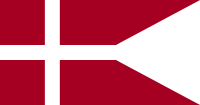
Back البحرية الملكية الدنماركية Arabic Marina Reial Danesa Catalan Dánské královské námořnictvo Czech Søværnet Danish Kongelige Danske Marine German Real Armada de Dinamarca Spanish نیروی دریایی سلطنتی دانمارک FA Tanskan kuninkaallinen laivasto Finnish Marine royale danoise French הצי המלכותי הדני HE
The Royal Danish Navy (Danish: Søværnet, lit. 'The Navy') is the sea-based branch of the Danish Armed Forces force. The RDN is mainly responsible for maritime defence and maintaining the sovereignty of Danish territorial waters (incl. Faroe Islands and Greenland). Other tasks include surveillance, search and rescue, icebreaking, oil spill recovery and prevention as well as contributions to international tasks and forces.
During the period 1509–1814, when Denmark was in a union with Norway, the Danish Navy was part of the Dano-Norwegian Navy. Until the copenhagenization of the navy in 1801, and again in 1807, the navy was a major strategic influence in the European geographical area, but since then its size and influence has drastically declined with a change in government policy. Despite this, the navy is now equipped with a number of large state-of-the-art vessels commissioned since the end of the Cold War. This can be explained by its strategic location as the NATO member controlling access to the Baltic.
Danish Navy ships carry the ship prefix KDM (Kongelige Danske Marine) in Danish, but this is translated to HDMS (Her / His Danish Majesty's Ship) in English. Denmark is one of the many NATO member states whose navies do not deploy submarines. However, historically Denmark has operated them, the submarines were retired in 2004 as part of cooperative defence agreement and restructuring. The Royal Danish Navy has operated a wide variety of vessels over the years, including different types of submarines, patrol boats, minesweepers, missile boats, and frigates. It has also operated a variety of aircraft, and the use of helicopters for search and rescue missions and transport, for example, has been a part of its mission.
- ^ "The Danish Defence Agreement 2005–2009 – Navy". Archived from the original on May 10, 2008. Retrieved 2008-06-25.
- ^ "Equipment used in the Navy". Archived from the original on 2008-06-07. Retrieved 2008-06-25.
- ^ "Danmark bombede Algier – og glemte alt om det". videnskab.dk. Retrieved 2011-08-29.

